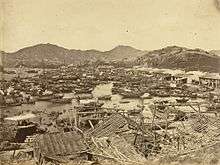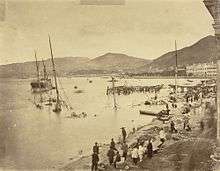1874 Hong Kong typhoon


The 1874 Hong Kong Typhoon hit Hong Kong during the night of Tuesday 22 September and the morning of Wednesday 23 September 1874.
Newspaper report from Hong Kong Daily Press
A report of a terrific typhoon in the Hong Kong Daily Press was subsequently quoted on the front page of the Singapore Straits Times on 10 October.[1] The typhoon hit Hong Kong during the night of Tuesday 22 September and the morning of Wednesday 23 September 1874, with no less than 2,000 people recorded as being injured. However, around 5,000 people lost their lives in Macau, making the typhoon the worst storm to hit Macau.
The Colony experienced a period of low pressure, typical of the eye of a typhoon. From 8 pm, winds raged and howled with ear-deafening sounds, alongside the painful cries of many people who had become homeless. The typhoon increased in strength steadily up to 2:15 am in the morning.
Some adventurers went out to the Praya at 11 pm and found themselves knee deep in the water and risked being washed away by the tidal waves hitting the shore. They were forced to retreat by 1 am as the winds were reaching a new high. The East Point on Causeway Bay recorded a water level 4 feet above its average. Many stores and shops, even far away from the Praya waterfront were flooded and water damaged.
The typhoon began weakening after 3 am, yet its two-hour impact had injured and killed many in the Colony. Telegraphic communication was interrupted and communication with Hong Kong island was cut for a time. The town had sustained great loss, its roads were deserted and strewn with debris, house roofs were ruined, windows shattered and walls fallen and cables and gas pipes were blown away and trees uprooted.
Most of the 37 ships in port were damaged and hundreds of fishing junks and sampans were either wrecked or broken up despite having sought shelter in the bay. At this time Hong Kong did not have its own weather observatory and many people were expecting the storm from a different direction, while others were caught off guard and either shipwrecked or lost their homes. A few false typhoon alerts had been announced earlier in the year.
The next morning, the Praya scene from west to east was heart-rending: one could easily find boats capsized and corpses floating and drifting on the water with some bodies washed ashore by the high tides.
Eyewitness
Ernest John Eitel, about one of Hong Kong's worst typhoons struck in 1874[2]
From his accounts, Eitel described Hong Kong being much devastated after this terrific strike from the 1874 typhoon. Many of the European and Chinese houses were ruined and became roofless; big trees were unrooted....and corpses were found from the ruins and started surfacing on waterfront from the wrecked ships.
An account by a first-time visitor
Mrs. Mary Crawford Fraser, (better known as Mrs Hugh Fraser), wrote about this unnamed 1874 Hong Kong typhoon in her journal[3]
Mrs Hugh Fraser as a new bride of a British diplomat left Italy on August 21, 1874, voyaging with her husband on board a P &O 8,000-ton steamer for Peking. The couple were approaching Hong Kong two days ahead of the September typhoon, which gave her a terrible fright. She reported in her journal that the sky was dark as ink, the sea oily and of the same colour and rough and wavy. The barometer's needle convulsed vigorously. Her vessel had to stay outside Hong Kong harbour to let the typhoon pass, following which she witnessed massive wreckage among which dead bodies floated on the surface of the sea. A P&O agent came on board and described how the typhoon took two hours to wreck Hong Kong to its foundations, sinking many foreign ships at anchor, and drowning many Chinese families who lived on the fishing boats or sampans. It was said to be one of the worst typhoons in the past 50 years to have hit the Colony.
When Mrs Hugh Fraser went ashore, she reported that the waterfront was nearly swept away, hardly a tree was left standing in the Botanical Gardens and many buildings were found roofless and in ruins. People were hastily burying the dead for the heat was intense and there was great concern over the outbreak of contagious disease. The low atmospheric pressure made the place feel like a huge burial chamber.
See also
References
- ↑ "TERRIFIC TYPHOON IN HONGKONG", The Straits Times, 10 October 1874, Page 1
- ↑ Eitel, Ernest John (1895). Europe in China: the history of Hongkong from the beginning to the year 1882. London: Luzac & Co.
- ↑ Mrs Hugh Fraser, (1911) A Diplomat's Wife in Many Lands. Hutchison & Co.: London. Vol 2, Chapter XXIII, Two weddings and a voyage to the East : in the wake of a typhoon, p397-400.
External links
Pictures
- A review of natural disasters of the past (p54-141). Courtesy. Hong Kong Museum of History. The typhoon on 22 September 1874. (photos on pp. 65, 67, 84, 86 and 94)
- 1874 Typhoon at Hong Kong | Gwulo: Old Hong Kong
- "The impact of the typhoon of September 1874 in Hong Kong. The Basel mission house."
| Wikimedia Commons has media related to 1874 Hong Kong Typhoon. |